Vol 1 No. 10 TROPIC LIGHTNING NEWS May 6, 1966
Index
[The 1966 Vietnam issues of Tropic Lightning News were published in Saigon,
and are of lower quality than later years that were printed in Japan. Over
the years the photographs and text have faded and it has been difficult to
reproduce them. Even when the photos are unclear, I have been included
them to give a sense of the activities in the Division.]
The 25th Infantry Division last week completed the final phase of its
deployment to Vietnam when the main body of the 1st Brigade landed at the South
China Sea port of Vung Tau.
Commanded by Colonel William B. Sandlin, Jr., the 1st Bde. consists of
Headquarters and Headquarters Company, 1st Bde.; 2nd Battalion, 14th Infantry
"Golden Dragons"; 4th Battalion, 9th Infantry "Manchus"; and 4th Battalion, 23rd
Infantry "Tomahawks". Accompanying the brigade on the final move was the 7th
Battalion, 11th Artillery "On Time".
The 2/14th Inf. has been awarded 31 battle streamers for action from the
Civil War to the Korean War. Ninth Inf., organized in 1855, joined the division
in February of this year from Ft. Wainwright, Alaska, and has been awarded 45
battle streamers.
Also originally from Alaska, 23rd Inf. arrived at Schofield Barracks in
February to join the division. The 23rd Infantry has been awarded 42 battle
streamers. The 7/11th Artillery has earned 14 battle streamers from World War I
to Korea.
Second Brigade arrived at Cu Chi last January. Since then, they have
accounted for 578 enemy killed.
The 3rd Brigade arrived in Vietnam last December, moving from Hawaii by air
and and sea, marking the largest troop airlift ever completed by the Air Force.
Division headquarters, Division Artillery and Support Command also
are located at Cu Chi.
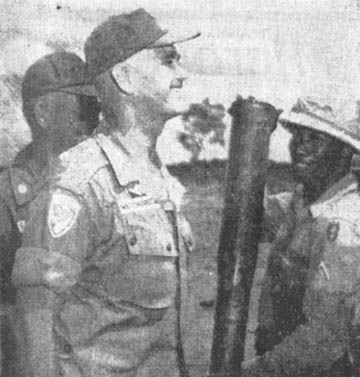 |
VISITOR - General William C. Westmoreland, Commander, US. Military Assistance Command, Vietnam, looks over cannister round from M-48 tank during tour of division base camp. Behind him is Lt. Col. R. J. Fairfield, Jr., 1st Battalion, 69th Armor commander. (Photo by Vickery) |
1/5th (Mech) Honors Four For V-N Service
Four soldiers from the 1st Battalion (Mechanized), 5th Infantry, were honored
in awards and decorations ceremonies at Cu Chi last week.
They are Captain John T. Sheridan, of Cranston, R.I., Staff Sergeant William
R. Oster, of Security, Colo., Sergeant Theodore R. Douglas, of Chicago, Ill.,
and Specialist Four George Gomes, of Charleston, S.C.
Presenting the awards was Lieutenant Colonel Thomas Greer, 5th Mech.
Commander.
Capt. Sheridan, the battalion intelligence officer, received the Bronze Star
with "V" device for heroism during an operation against the Viet Cong on
February 14. During a reconnaissance mission near Cu Chi, Capt. Sheridan
assumed command of A Company when the company commander was killed under heavy
sniper fire.
He quickly directed retaliatory fire and organized a defense perimeter with
one platoon to evacuate the dead and wounded by helicopter. The 26-year-old
captain then led a successful withdrawal without sustaining further casualties.
Sgt. Oster received the Army Commendation Medal with Oak Leaf Cluster for
meritorious service in Vietnam from August 1965 to December 1965 while serving
as the platoon sergeant of a gun platoon for the 114th Aviation Company. He was
awarded his first Army Commendation Medal in November 1964.
Sgt. Douglas was presented with his third Air Medal for serving as a
volunteer "shotgunner," also with the 114th Aviation Company.
Sp4 Gomes won the Army Commendation Medal for meritorious service
in Vietnam from September to December of 1965. He flew shotgun for the
114th Aviation Company.
NEW BRIGADE TO BE FORMED AT BENNING
The Army has announced plans to activate a 3,800-man infantry brigade at Ft.
Benning, Ga., in June. The 199th Infantry Brigade initially will conduct basic
combat and advanced individual training for the men assigned to it.
The unit is the second of the Army's new brigades which were announced
earlier and scheduled for activation in the coming months. The first was the
196th Infantry Brigade. activated at Ft. Devens, Mass., in September 1965.
Major components of the 199th will be the 2nd Battalion, 3rd Infantry; 3rd
Battalion, 7th Infantry; 4th Battalion, 12th Infantry; and the 2nd Battalion,
40th Artillery.
Colonel George D. Rehkoof, of Chevy Chase, Md., will command the brigade.
3rd of War
Medal of Honor Given
PFC Milton L. Olive, III, became the third man to be awarded the Medal of
Honor last week when President Johnson presented his parents with the
posthumous honor.
A member of 173rd Airborne Brigade, Olive received the medal for having
thrown himself on a Viet Cong hand grenade, which landed near him and several
other members of the Bien Hoa-based unit.
The action occurred while Company B, 2nd Battalion (Airborne), 503rd
Infantry, was on a search-and-destroy operation near Phu Cuong, Vietnam, last
October.
Lauded for his sacrifice, the official citation pointed out that "through his
bravery, unhesitating actions, and complete disregard for his own safety, he
prevented additional loss of life or injury to the members of his platoon..."
The President, in making the award, said, "In dying, Private Milton Olive
taught those of us who remain how we ought to live."
"I have never understood how men can glorify war. The rocket's red glare,
the bombs bursting in air," has always been for me better poetry than
philosophy. "When war is foisted upon us as a cruel recourse by men who choose
force to advance policy, and must, therefore, be resisted, only the irrational
or the callous, and only those untouched by the suffering that accompanies war,
can revel."
Concluding his remarks, President Johnson quoted a letter he had received
from Milton B. Olive, Jr., the father of the eighth Negro to be awarded the
Medal of Honor.
"It is our dream and prayer that some day the Asiatics, Europeans, the
Israelites, the Africans, the Australians, the Latins and the Americans can all
live in one world. It is our hope that in our own country the Klansmen, the
Negroes, the Hebrews and the Catholics will sit down together in the common
purpose of good will and dedication; that the moral and creative intelligence
of our united people will pick up the chalice of wisdom and place it upon the
mountaintop of human integrity; that all mankind, from all the earth, shall
resolve "to study war no more." That, Mr. President, is how I feel and that is
my eternal hope for our great American society.
"Ladies and gentlemen, I have no words to add to that."
Col. Jones Named New Liaison Officer
Air Force Lieutenant Colonel Henry A. Jones, of Shawnee, Okla., has been
assigned as liaison officer to the 25th Infantry Division. The new liaison
officer recently was promoted to his present rank.
The duties of liaison officer are not new to Col. Jones. He has served as
liaison officer to the 11th Airborne Division, the 24th Infantry Division and
the 2nd Armored Division.
His wife, Margaret, resides in Hampton, Va. His mother, Mrs. John W. Jones,
still lives in Shawnee, where Colonel Jones was graduated from Shawnee High
School. He is presently an active member in the Masonic Lodge and the India
Temple.
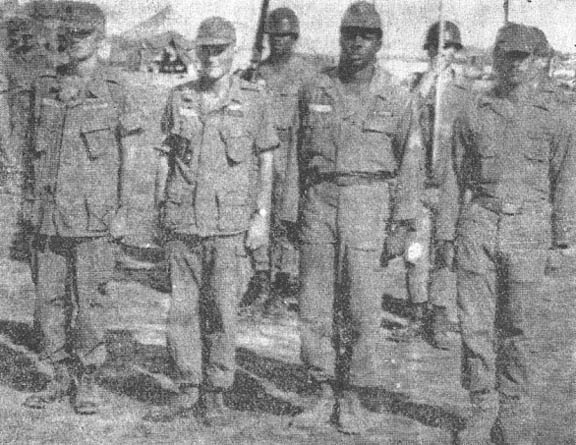 |
| DECORATED - Four members of the 1st Battalion (Mech), 5th Infantry, shown before receiving awards last week at Cu Chi. From left : Capt. John T. Sheridan, SSgt. William R. Oster, Sgt. Theodore R. Douglas, and Sp4 George Gomes, who received honors from Battalion Commander Lieutenant Colonel Thomas Greer. (Photo by Kleinberg) |
Page 2 TROPIC LIGHTNING NEWS May 6, 1966
Live and Let Live - II FFV
Living in Vietnam can be as rewarding as each individual will make it. A
country of ancient traditions and charm, Vietnam presents a marked contrast to
the ultra-modern society of the United States.
Much of the experience the American soldier acquires while here will be
provided by the Vietnamese people. But it is a relationship which is
reciprocal; it is not all take and no give.
To offer guidelines in Vietnamese-American relations, II Field Force,
Vietnam, has provided an outline for the U.S. soldier in Southeast Asia.
Identify yourself with the goals and interests of the local people by
following their customs, using their language and understanding their way of
life.
Treat women with politeness and respect. Make friends among the working
people and assist them personally. Demonstrate to the people your knowledge of
their government and your respect for its officials and laws.
Show the Vietnamese soldier that you know and respect his rank and
experience.
Always give the people the right of way when you drive. Don't attract
attention by loud or rude behavior. Don't separate yourself from the people by
an open display of wealth or privilege.
Remember security, remain alert and be ready to react with your military
skills. Give help and cooperation to the other Americans and allies who are
here assisting the Vietnamese people.
Consider carefully the VC tactics before making decisions which affect the
lives and property of the Vietnamese people. Treat VC captives according to the
Geneva Convention.
Don't forget where you are and why you are here. Always use self-restraint
and consciously avoid any actions which would discredit our motives and weaken
our standing with the Vietnamese people.
|
GOING UP
|
Viet Cong Enlist Microbes' Aid
Hiding in places you'd never look is an enemy that can strike and make you a
casualty. He's the "VC ."
The "Viet Crud" will make you a loss just as surely as a well-aimed bullet.
The two VC's are both formidable enemies.
In any tropical climate, skin infections are a major health problem because
of the constant flow of perspiration and dirt accumulation on the body.
Soap is the defense.
Follow these few simple rules of combat and you will wage an effective war on
infection:
Bathe the entire body daily whenever possible, making sure that the area
under the arms, in between the legs, and the feet are thoroughly washed and
rinsed.
Clean and trim fingernails and wash hands before eating and after a latrine
visit.
Change socks and underwear daily and outer garments whenever possible. Dirty
laundry must be thoroughly washed, rinsed and hung in the sun and open air to
dry.
When this new "VC" catches you off guard, just like the "old" VC, he will
strike. The above hints will be your armor against his probes. If he is
successful in his attempt then you must strengthen your defenses to repel his
attack
Any minor cut or abrasion is especially vulnerable to infection. This
infection grows quickly and a small wound can become a severe infection. Keep
the minor wound especially clean and protected from contamination.
When a skin infection takes hold, go to sick call for proper medical
attention. A skin disease is persistent and requires equally persistent effort
to cure. Follow carefully the advice given at the aid station.
Remember, "Win in Vietnam - against the Viet Crud."
Editorial
Bonds: Your Best Buy
Almost a quarter of a century ago a secretary of the treasury coined the
slogan, "They gave their lives - you give your money." A The slogan helped kick off a
drive which sold more than $18 billon worth of U.S. Saving Bonds to back up our
fighting men.
That was during World War II, when all stops were pulled out in an effort to
support American men on the battle lines. The situation has its similarities.
True, the nation is not involved in global war, but we are not at peace.
More than 300,000 American servicemen are deployed across Southeast Asia as part
of a systematic effort in the postwar period to guard over the shaky peace in
other parts of the world. An investment in U.S. Savings Bonds is an investment
for the job being done here.
At the same time, an investment in savings bonds is an investment in our own
future. With the new 4.15 per cent interest rate, U.S. Savings Bonds provide a
sound form for the growth of our savings dollar.
The maturity period of Series E Bonds sold since Dec. 1, 1965, has been
reduced from seven years and nine months to seven years. A regular monthly
savings plan of $18.75 (for a $25 bond) will accumulate $1,797 in seven years.
The bonds purchased will have a maturity value of $2,100.
President Johnson has called investment in U.S. Savings Bonds "both prudent
and patriotic." Think it over. Start a monthly bond allotment and let it build
for the future. (AF-PS)
Embassy Warns Against Signing Accident Forms
American citizens in Saigon rarely know either the Vietnamese or French
languages well enough to read and understand the contents of an accident report
furnished by a Vietnamese police officer if any accident occurs. For that
reason, the U.S. Embassy has ordered Americans not to sign such reports. The
Embassy will assist them in reporting the accident officially to the precinct
Police Headquarters.
The Embassy order is not intended to relieve the American concerned of any
responsibilities he may legally have in connection with an accident, but to
avoid any possible misunderstanding due to language difficulties
Should you be involved in an accident and no military policemen are nearby,
contact the U.S. Embassy, Marine Security Guard at 20.713 for assistance.
Your Rights Follow by Absentee Ballot
This is a general election year, one in which one-third of the United States
Senate and the entire membership of the House of Representatives will go to the
American people for election or reelection.
Members of the armed forces have the right to vote by absentee ballot as
established by the Federal Voting Assistance Act of 1955.
While state laws vary on the specific administration of absentee voting, the
Voting Assistance Act explicitly outlines who is eligible to cast his ballot by
absentee. They are
* Members of the armed forces while in the active service and their spouses
and dependents.
* Members of the Merchant Marine of the United States, and their spouses and
dependents.
* Civilian employees of the United States in all categories serving outside
the territorial limits of the United States and District of Columbia, and their
spouses and dependents when residing with or accompanying them, whether or not
the employee is subject to the civil service laws and the Classification Act of
1949, and whether or not paid from funds appropriated by Congress.
* Members of religious groups or welfare agencies assisting members of the
armed forces who are officially attached to and serving with the armed forces,
and their spouses and dependents.
Standard Form 76 (Federal Post Card Application for Absentee Ballot) is the
official application blank available to armed forces personnel to cast their
absentee ballots. It, in itself, is NOT a ballot, but contains the necessary
information for you to make application for the actual ballot.
In many cases, the form also provides applicants with automatic registration,
dependent upon state laws. Some states, however, require that you register
separately from the post card application.
While a number of states permit absentee registration, here are those which
insist upon registering in person, making the service member who has not already
registered ineligible to vote in that state.
Again dependent upon existing state laws, absentee registration can be
permanent until service members leave active duty, at which time they must
re-register.
For voting purposes the legal residence of members of the armed forces is
generally the state from which they entered military service. This home state
remains as the only state in which a person in the armed forces has the legal
right to vote unless certain conditions are met. All states will permit persons
in the armed forces to acquire a new voting residence within their
jurisdiction. When this is accomplished, voting rights in the old state of
residence are lost.
Service personnel desiring to acquire a new voting residence must meet the
new state's legal requirements. They must have lived within the state for the
required length of time, normally must not have resided exclusively on military
property, and presently must intend to make the new state their permanent home
when they retire from active duty or are released from active service.
The law usually holds that the voting residence of the wife is the same as
that of her husband. Where there is any question pertaining to voting residence,
see your legal assistance officer.
The poll tax, which has been in existence in Alabama and Texas for some
years, is under legal dispute in the courts and may be stricken before this
year's general election. In those two states, voters may not cast their ballots
until the poll tax has been paid and all tax unpaid from previous years is
brought up to date.
While voting in general elections by absentee ballot is virtually universal,
some states will not permit absentee votes to be cast in primary elections, some
of which are being held this month.
Citizens of Guam, Puerto Rico and the Virgin Islands may not vote in United
States general elections, although they do conduct elections within the
territories for local officials. Puerto Rico, which will not hold general
elections until 1968, has no provision for absentee voting.
Voting officers throughout the 25th Infantry Division can provide information
concerning specific requirements and laws in your home state. They also have
available DA Pamphlet 360-503, "Voting Information 1966," which contains most of
the information necessary for you to cast an absentee ballot this year.
| The TROPIC LIGHTNING NEWS is an
authorized, publication of the 25th Infantry Division. It is published
weekly for all division units in the Republic of Vietnam by the
Information Office, 25th Infantry Division, APO U.S. Forces 96225. Army
News Features, Army Photo Features and Armed Forces Press Service material
are used. Views and opinions expressed are not necessarily those of the
Department of the Army. Printed in Saigon, Vietnam, by Dai Doan Ket
Publishing Company. Maj. Gen. Fred C. Weyand . . . . Commanding General Maj. William C. Shepard . . . . . . Information Officer Sp5 Dale P. Kemery . . . . . . . . . Editor |
Page 3 TROPIC LIGHTNING NEWS May 6, 1966
Bridge of Friendship Ends Here
| EXAMINATION - Captain Eugene W. Goertcen, surgeon for 3rd Squadron, 4th Cavalry, gives medical assistance to a villager at Bac Ha. (U.S. Army Photo by Pardue) |
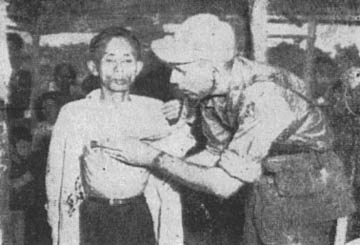 |
WITH MEDICINE...
In the small relocation village of Bac Ha, almost tangent to the divisions
outer perimeter, the young scuttle through the dust as they hurry their parents
to a small thatched-roof hut.
Posted outside are signs of communist influence. Within, a small girl
timidly slides on a chair and, before her, a doctor prepares for his daily work.
Her unkempt, long, black hair hangs limply on her shoulders while her liquid
brown eyes cling to the doctor's every move. Catching a glimpse of the syrette,
she shifts her eyes to solicit her mother's approval. Realizing her fate, she
slowly lowers her dusty pajamas and bows for the needle.
As she howls in protest, the little ones peeking in begin a retreat, leaving
little trails of dust behind. A few minutes later they are outside the hut
again, this time held by mothers firm grip.
It is a normal experience for the people of Bac Ha, for, since the division's
arrival, Bac Ha has been included in the U.S. Medical Civic Action Program (MEDCAP).
The program extends medical assistance to the people of South Vietnam.
To help the unfortunate further, the citizens of Hawaii have donated health
and sanitary items through "Operation Helping Hand." Through the program Bac Ha
is enjoying, as will many similar villages, what most Americans consider the
necessities of life.
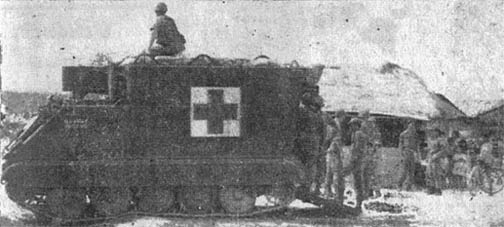 |
PROTECTED MEDICINE - An armored personnel carrier from 3rd Squadron, 4th Cavalry, waits outside the village of Bac Ha, filled with medical supplies, for the villagers. (Photo by Pardue) |
...AND SCHOOL SUPPLIES...
The normally expressionless faces of more than l,200 youngsters in the
village schoolhouse at Tan An Hoi sparkled with gratitude last week as Division
Artillery distributed school supplies donated by the people of Hawaii in
"Operation Helping Hand."
The youngsters, decked out in white and blue, lined up outside the
schoolhouse for the arrival of the men with the red and yellow shoulder patch.
The division band gave a short concert in the courtyard.
Inside, waiting to greet the Americans, were the Cu Chi district chief, the
village chief of Tan An Hoi and the principal and teachers of the Tan An Hoi
school.
Following a series of addresses by the school officials, the youngsters
passed by their principal, one at a time, to pick up the school supplies, which
included pens, pencils, textbooks and notebooks.
| BOUNCE! BLAM! - Youngsters in Bac Ha give the bounce-and-burst test to balls and balloons sent from the United States. (U.S. Army Photo by Williams) |
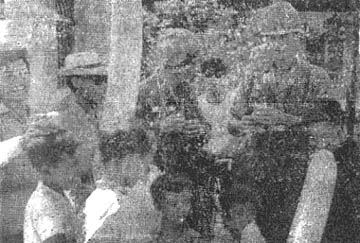 |
EVEN WITH BALLOONS...
The men of B Company, 1st Battalion, 27th Infantry, are charged with
protecting the Catholic church and people of the village of Bac Ha, located
outside 2nd Brigade's perimeter.
But two of the men feel that providing security is not enough. They wanted
to do something for the children living in what was once a meeting place for
Viet Cong local forces.
So PFC Daniel Brumfield, 21, of Highpoint, N.C., and Specialist Four Wendell
Bailey, 25, of Portsmouth, Ohio, wrote to their parents and asked for toys.
About a month later, boxes containing rubber balls and thousands of balloons
arrived. They were given to village priest Reverend Tran Van Phan, who
distributed them to the children.
And now in Bac Ha, to Coke, chewing gum, G.I. hats , and "okay," add two more
Americanisms: play ball and break-the-balloon.
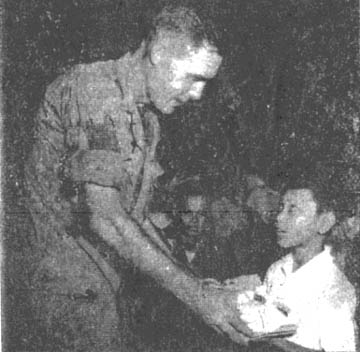 |
THANK YOU - Major DeSaussure Bull, sub-sector U.S. adviser for Tan An Hoi, distributes, school supplies to the Vietnamese students of Tan An Hoi school. (Photo by Pardue) |
...CLOTHING AND TOYS
"Tropic Lightning Helping Hand" went out to the people of Kontum Province for
the first time last week as 3rd Brigade extended aid to villagers in Dak To, 60
miles northwest of Pleiku.
When the first shipment of Helping Hand material arrived at the brigade's
base camp, Lieutenant Al Marrow, brigade civil affairs officer, wanted a
particularly worthy place to donate the items to the Vietnamese.
Such a place is Dak To, site of a Vietnamese government refugee collection
point. It is there that a 50-man team is working to help relocate several
thousand Montagnards, who have escaped from their Viet Cong-harassed villages
north of Dak To. Many of the refugees number among the families of former Viet
Cong who have surrendered under the government's "chieu hoi," or open arms,
program.
More than 270 Montagnards were living in the resettlement center when Lt.
Marrow's jeep and trailer, laden with clothing, toilet articles and toys, pulled
into the area.
Members of the resettlement team had the refugees assemble to receive Lt.
Marrow's gifts through the acting village chief.
As the goods met their final destination from Hawaii to the Central
Highlands, the refugees' tired, worn looks gave way at once to bright smiles as the clothing
and other items were distributed.
The resettlement team consists of National Policemen, Vietnamese Information
Service personnel, medical teams, dancers and a band. They take in the refugees
as they come, register them, then house and feed them until they can be
relocated permanently in one of the nearby villages.
Since many of the refugees are from Viet Cong backgrounds, the treatment they
receive at Dak To is crucial in strengthening their allegiance to the
government.
| HELPING HAND - Vietnamese children from the Tan An Hoi school show off their new school supplies to two "Tropic Lightning" soldiers, Specialist Four Curt Hewlin, of Enfield, N.C., Division Artillery, and Staff Sergeant Richard A. Delacruz, of Honolulu, 25th Infantry Division Band. (Photo by Pardu) |
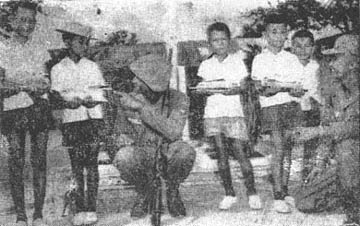 |
Page 4 TROPIC LIGHTNING NEWS May 6, 1966
Slow Start, Fast Finish for 69th Armor
BY PRIVATE McLIGHTNING
The only time to write a story about armor tactics is right after the fight
is over and you can still portray how tired you are. That's the only lime to do
it, but, after operation King, I was just too tired to try.
My object in going with 1st Battalion, 69th Armor, was to compare it with an
armored cavalry excursion a week or so ago. There is no comparison. There is
no stealth involved where tanks are concerned.
At the gentlemanly hour of 9:15 a. m., I received a call: "If you want to go
along with us, get right over to my 'charlie papa!' " I did.
Capt. Paul King, from Dunbar, W. Va., was issuing his orders to the rest of A
Company's officers when I walked in.
"The infantry found a new tunnel network in this area yesterday, and today
we're going in there and destroy anything that's left." Capt. King looked
around to make sure everyone was looking at his map. "We enter the area from
the west and work east. I want you to tear up this area and shoot at anything
that shoots at you."
It was an orderly march through the outer wire and onto highway one. Then
the tempo picked up as the tankers found some smooth sailing down the asphalt.
The radio crackled to let the command vehicle know the lead element had come
upon a road block. The column automatically took to the paddies to bypass the
pile of tree limbs and trash that crossed the road. The incident was reported
to the battalion at the Cu Chi base camp and the armor continued down the road.
The column made a right turn at the outskirts of a small hamlet and soon was
in the middle of a rice paddy. Something is wrong. I can feel it like
electricity ruffling the hair on the back of my neck. There is no one working
in the fields.
The tanks change from their column formation and spread out over the field so
that they are supporting each other.
"Dismount your 'doughs'," Capt. King barks the command into the radio to his
platoon leader, Lieutenant Freeman Carr, from Northfield, Vt. The infantrymen
start sliding off the iron brutes and dropping to the ground.
Nothing, absolutely nothing, happens. The tanks, with their
big guns moving, pointing at possible trouble spots, rumble into a nearby wood
line and are swallowed by the big clumps of bamboo that form the hedgerows.
The 'doughs',
playing follow the leader, protect the tank commander from the ever present
threat of the VC infantryman who pops up from his hole after the "big boys" pass
by.
Row after row, the bamboo clumps are pressed down, and their crunch and the
groan of the engines are the only sounds to be heard.
CRACK! There it was. The distinct report of a rifle. I don't know where it
came from, but that VC never should have done it. It was the signal for
mayhem. The advance elements searched with fire to the front. All guns
blazing. The flank platoons did the same in their sectors.
The noise was deafening and the smoke and acrid smell of burned powder were
everywhere. As the lead elements continued their push, several VC buildings
came into view and were ground into the earth by the heavy tanks.
Anti-personnel mines, set as booby traps in the hedgerows, popped harmlessly
like pop corn under the steel treads.
"I've got two for dust-off." The message from Lieutenant Patrick Ward, from
San Marino, Calif., came as a complete surprise. "It's two of my doughs."
A quick flick of the switch on the radio and Capt. King had the medics on
their way to help the injured. Another quick call and arrangements for the
helicopter medical evacuation were complete. Then we headed towards the wounded
soldiers.
"They got out of the track, but just a little," explained the infantry
platoon as we approached.
"Well, this is a war of inches," Capt. King remarked. Then he added, "How
are they?"
"It was a bamboo booby trap." The lieutenant pointed toward the hedgerow.
"The first man tripped it and caught pieces in his tail. The man behind lost
some meat on his legs, but they're okay."
The red smoke grenade was tossed as the 'Huey' circled, looking for a safe
area. He landed and, with precision, the two men were loaded and airborne
within seconds.
We returned to our original position in time to see Lieutenant William
Muehsem, from Springfield, Penna., put the coup de grace on a VC store house
with the blade of his vehicle tank recovery. "That's where that first round came from," he
explained.
The VC got the message and stayed in hiding while the company made mince meat
of their staging area. Two thousand pounds of precious rice were liberated.
Their bunkers were destroyed and carefully placed-booby traps were exploded
harmlessly.
"We don't often see the VC on these search and destroy missions anymore,"
Capt. King smiled. "They've found out that to shoot at a tank with a rifle
isn't habit forming."
|
United States |
Mail, Compliments of Hess
Specialist Four William B. Hess, mail clerk for Company B, 1st Battalion
(Mechanized), 5th Infantry, hates to send the soldiers in his company away
without correspondence from home, so he did something about it.
Appealing to the readers of the Chicago Daily News, Hess, of Riverside, Ill.,
wrote:
"...A man cannot return from a two- or three-week operation - tired, hungry
and depressed - to find that no one in the country . . . has cared enough to
acknowledge his existence with two lines on a post card..."
The response was almost overwhelming - far more than two lines on a post
card.
More than 50 letters poured into the company the first day and many more the
following days, - all of them offering encouragement and seeking to start
correspondence.
Hess, 22, tacked them on the company bulletin board, the most popular spot in
the company. Those who were interested - and there were many - either wrote
directly or had Hess forward their address.
A former line soldier, Hess was trained in Hawaii as a clerk typist. "When
they pulled me off the line and put me here," he said, "I found many of the men
weren't getting enough mail."
Hess said he got tired of sending the men away without mail. "They'd sulk
for hours," he said. "Many of the soldiers were receiving only one letter a
week," Hess remarked, "and I hardly consider one letter a week enough." The
mail clerk has big plans for what he likes to call 'Operation Snowball.' He
already has contacted some other company clerks to see if the idea can be
expanded. He even envisions the inclusion of all division units at Cu Chi and
possibly all other units in Vietnam.
After all, Hess insists, the exchange of letters will boost morale and
further understanding of the war.
Girls between the ages of 17 and 20 draw the biggest crowd, although a
23-year-old secretary from La Grange, Ill., was doing pretty well.
So was Bobby Steinborn, who wrote, "I'm 12 years old and always wanted a big
brother to talk to about sports instead of a nine-year-old sister . . . if my
soldier friend wants to know the top tunes, I will tell him."
| DEAR JOE - PFC James C. Fewell, a driver for Company B, 1st Battalion (Mechanized), 5th Infantry, looks for a pen pal on the company bulletin board. |
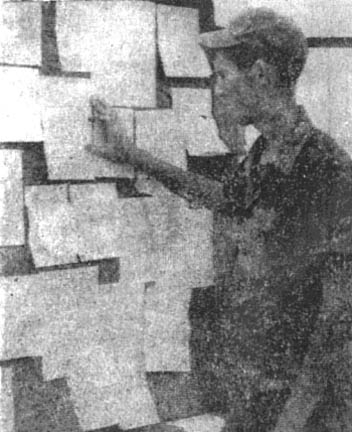 |
Soldier Lauds M-79 For V-N Performance
The M-79 grenade launcher looks like a child's rifle that shoots ping pong
balls, but it is fast becoming one of the most valuable weapons of the
infantryman.
In previous wars, most rifle teams were accompanied by at least one man armed
with a grenade launching device but something was needed to provide additional
speed, distance and accuracy.
The M-79 grenade launcher, sometimes referred to as a portable, short-range,
mortar weapon, was developed early in the 1960s. It is designed to hit the
enemy at distances too short for conventional mortar fire and too long for a
hand grenade.
PFC James Warren, of Converse, Ind., a member of Company B, 1st Battalion
(Mechanized), 5th Infantry, can attest to the weapon's performance.
Warren learned how to fire the weapon at Ft. Jackson, S.C., and has used it
the last three months with the 2nd Brigade. It has come in handy on more than
one occasion.
"We were searching a 'hooch' near a cane field when someone opened fire on
us," Warren said. "I couldn't see anybody, but I kept firing the M-79 into the
field at the sand. I may not have got him, but he stopped firing."
Warren cited another incident during operation Honolulu where the squad came
under grenade fire and was saved by the M-79.
This time, the unit was receiving fire from Viet Cong rifle grenades. Warren
said they could not determine the direction of fire. After he fired five or six
rounds in the general direction, the fire stopped.
"It's really an easy weapon to fire." Warren said. "It doesn't have many
moving parts, and I've never had a misfire with it. I've had a squad leader ask
me to come into his squad as a machine gunner, but I'd never give up the M-79."
The M-79 is accurate up to its maximum effective range of 400 yards. Warren
says if he sets his sights at a target 200 yards distant, the grenade will hit
it. Its bursting radius is three yards.
The grenade automatically arms itself after 15 to 30 yards in flight. There
have been cases where the grenade has hit a close object and not exploded. This
provides the grenadier with built-in protection in case of an accidental
discharge or if he is forced to fire from a clump of bushes.
Warren and the others carry only the M-79 grenade launcher and a .45 caliber
pistol, but most American soldiers will tell you - and probably the Viet Cong,
too - that's enough.
Page 5 TROPIC LIGHTNING NEWS May 6, 1966
Punji Stakes Take Toll
"Dustoff," code word for medical evacuation by helicopter, crackled over a
Jeep mounted radio. "Total of ten," the voice said.
And the medics of Company B, 25th Medical Battalion, commanded by Captain
Edward Denison began readying the receiving tent at the field hospital for the
arrival of the wounded. Every piece of equipment that might be needed was
prepared.
When the helicopters landed minutes later, several stretcher bearers were
waiting to help their patients get to the admissions tent.
All ten men had leg injuries.
"Punji slakes! All over the LZ (landing zone) there were hundreds of them,"
one of the wounded men said.
The ten soldiers were participating in 3rd Brigade's operation Longfellow in
the northeastern portion of Pleiku Province.
According to a squad leader, who was one of the walking wounded, "We were
going into an LZ to set up security for the next wave of choppers. When we
landed on the road, everyone moved off the road into the brush. That's when we
hit the stakes."
Another squad leader from the same company said, "One of the men in my squad
was behind me and I heard him yell, Medic! I turned around and started back to
see what was wrong when a sharp pain stabbed my leg. When looked down, I saw
blood both on my leg and on a dirty piece of bamboo sticking up about a foot out
of the ground."
The brigade intelligence officer, Captain Ron Rabin, was at the scene of the
incident later and explained, "The stakes were relatively old. They had been
put in the area anywhere from two weeks to a year ago."
The medics and doctors at the field hospital treated all the men by cleaning
out the wounds, applying medicines, bandaging and giving injections to prevent
tetanus.
The soldiers were in the hospital at the 3rd Brigade forward command post for
less than an hour before being evacuated to the rear area for further
observation and treatment.
It was a telling reminder that not all enemies in Vietnam carry weapons.
Brothers Gerard Meet In Division Maneuver
Today's shrinking world and a war have brought two brothers together on a
dust-torn airfield. Major Robert J. Gerard and Captain Jacques B. Gerard met at
Cu Chi, thousands of miles from their home in Orange, N. J.
Maj. Gerard, now an aviator and operations officer for the 173rd Aviation
Company, served in Verona, Italy, three years before his assignment to Vietnam.
Capt. Gerard, meanwhile, served three years in Hawaii as a reconnaissance
platoon leader. He was later executive officer for Headquarters and
Headquarters Company, 1st Battalion, 27th Infantry, and then assistant supply
officer of the 2nd Brigade.
Maj. Gerard arrived in Vietnam on February 27, exactly two weeks to the day
after his brother's arrival, but the two did not meet until the 2nd Bde.'s
operation Honolulu near Cu Chi.
Maj. Gerard flew resupply missions during the operation and worked
hand-in-hand with Capt. Gerard, in charge of aerial resupply.
Maj. Gerard, 35, a University of Southern Mississippi graduate, entered the
Army on March 16, 1951. He was the commanding officer of the 110th Aviation
Company at Verona before being called to Ft. Benning, Ga., to assemble an air
mobile unit for duty in Vietnam.
Capt. Gerard, 25, entered the Army on June 3, 1962, after graduating from
Pennsylvania Military College at Chester, Penna., with a bachelor's degree in
business.
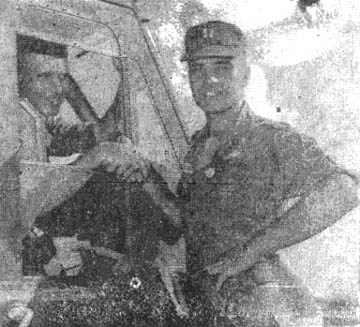 |
GREETINGS - Maj. Robert J. Gerard (left, shakes hands with his brother, Capt. Jacques B. Gerard, after meeting for the first time in three years. (Photo by Hanson) |
NCO's Active Imagination Becomes All Too Real
The men of the division expected to see and do battle with the Viet Cong,
natural elements and heat when they were sent to Vietnam. No one remembered to
tell them, however, that they also might be forced into quarreling with a
nine-foot-long iguana.
It was understandable, then, that Sergeant Alfredo A. Barrera, a fire team
leader for Company B, 1st Battalion (Mechanized), 5th Infantry, was unprepared
for his encounter.
He was guarding the bridge at Outpost Ann-Margret on the 2nd Brigade
perimeter when he saw "IT" moving across the road.
"I peeked out of the bunker, grabbed my rifle and ran out to see what it
was," Barrera said, "but the thing jumped into the water."
A track (armored personnel carrier) came by and, when I told the men inside
what I'd seen, they said I had been in the sun too long and was seeing things.
Then they rode off laughing."
Lurking in the shadows by the river for another 20 minutes, Barrera began to
doubt his own sanity. But the unpleasant looking monster was too curious.
When he pushed his nose from the river, the lizard was greeted with a single
round from Barrera's M-16 rifle.
Barrera now has the iguana's hide as a memento of his tour in Southeast Asia,
and a last laugh on a few of his friends.
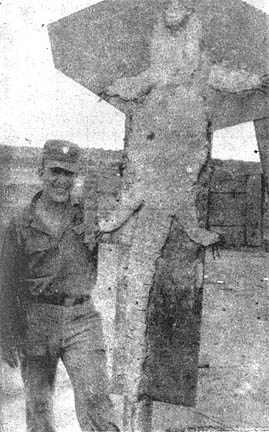 |
NIGHT OF THE IGUANA - Sergeant Alfredo A. Barrero, of Company B, 1st Battalion (Mechanized), 5th Infantry, displays the iguana that didn't get away. (Photo by Kleinberg) |
Electronic Eyes Spot Enemy
A man in a bunker, under ideal conditions, can see somewhat less than 100
yards at night.
But now, thanks to a variety of new radar devices, the American soldier is
using modern technological advances to improve his vision.
Short-range, nighttime radar, designed to spot and pinpoint all types of
enemy movement, has become a familiar, if somewhat strange picture in the
American front line foxhole.
It has been just such a device that the three radar squads of 1st Battalion
(Mechanized), 5th Infantry, have been able to give their near-sighted companions
a set of electronic glasses.
Armed with the AN/PPs-4 radar, $8,000 dollars worth of vision, the radar
squads are capable of detecting movement from 100 to 1,500 yards in the darkest
night.
Although the AN/PPs-4 is indiscriminate in distinguishing between Americans
and Viet Cong, it can spot almost anything from ants - if that's the quarry - to
huge vehicles.
No job for amateurs, radar operation is a series of squeals and blips
requiring extensive training to learn the difference between size of objects and
the noises the radar unit makes in sounding the warning.
"You have to learn to recognize the sounds," said Sergeant Rex McCoy, of
Elwood, Kans., a team leader for Company B. "It usually takes awhile. For
instance, a jeep really is high-pitched. The sound usually gets lower for
heavier vehicles."
Since the device is blind to the differences between friendly and enemy
troops and vehicles, all personnel and vehicle movements are reported to the
command post and, unless fired upon, the radar team will not fire.
When 2nd Brigade first arrived at Cu Chi in January, the electronic radar
eyes spotted enemy movements near the perimeter on several occasions, allowing
fire to be called in before any damage was done.
Gutzman Shield Flies Above Tanks
A new flag is flying in Vietnam. It bears the Gutzman family coat of arms
and waves from the radio masts of the tanks in Company C, 1st Battalion, 69th
Armor.
Company C adopted its new banner in combat three weeks ago during operation "Kaena."
Says Captain Philip C. Gutzman, company commander, "Things were slow so I got
out my flag and tied it to the radio mast as sort of a morale booster. The next
thing I knew, everybody wanted one."
The upper half of the flag is white, the lower half green. Embroidered in
the center is a black Maltese Cross bordered in red.
Capt. Gutzman long has been interested in heraldry and has always liked
his family coat of arms. He first used it on his jeep while at the Pohakuloa
Training Area in Hawaii in 1964.
The flag Capt. Gutzman has now was sent to him by his wife. The flags for
the other 18 vehicles in the company were made in Cu chi.
Page 6 TROPIC LIGHTNING NEWS May 6, 1966
Jackpot Hit at QM Laundry
The hard-washing men of 506th Quartermaster Company at Cu Chi have had little
trouble finding customers, although many have proved to be somewhat forgetful
and a bit careless.
The 506th pulls almost 20,000 gallons of water out of the ground daily to
launder the clothing received from 2nd Brigade, but they have, at times, a more
exciting secondary occupation.
Just like mom used to do back home, someone must clean out Johnny's pockets.
Specialist four Miguel Vega, of Salinus, Puerto Rico, one of the brigade's
"moms," reports that he's found during his daily pocket-picking task -
everything but a Vietcong - so far.
"We've found ammunition, toilet paper, spoons, knives, watches, personal
letters, money, dog tags and candy. Specialist Vega said. "We've even had parts
of grenades left in pants pockets.
At high temperatures, such as those reached in the drying process, explosives
could shake up the laundry.
"At one time, I didn't check all the clothes, Specialist Vega said. "Then
one day I looked in the washer and saw a grenade going round and round. Now I
check them all."
"We should get CIBs (Combat Infantryman's Badge) for this job."
Specialist Vega also says that anything found that could remotely be
considered a security risk - such as letters and, once, a map - is burned.
But, the 506th would probably admit, unless things slack off a little, 2nd
Bde. could easily open a dime store hock shop, although no one is sure what kind
of customers could be expected.
| WHOOPS! - Laundry workers at the 506th Quartermaster Company find everything from gum to grenades while turning pockets inside out at Cu Chi. (Photo by Kleinberg) |
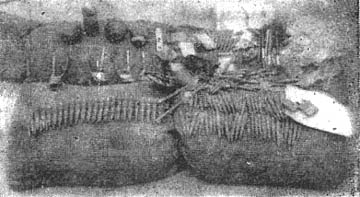 |
Countersigns Harass V.C.
The Viet Cong have gone into the sign-making business. D Troop, 3rd
Squadron, 4th Cavalry, found a Viet Cong poster tacked to a tree about three
miles northwest of the base camp. It read: "Attention. This is a death area.
Do not enter. Stay in the safe area."
When Major General Fred C. Weyand, division commander, saw the sign, he
decided to retaliate by ordering similar signs posted around the division's
perimeter.
The job fell to Second Lieutenant Leon Fox, of the 246th Psychological
Warfare (psy war) Detachment.
Lt. Fox contacted several printers and ordered 1,000 posters. The signs
read: This is U.S. 25th Infantry Division country. Any Viet Cong advancing
beyond this point will be shot.
But Lt. Lox didn't want to wait three to five weeks for delivery of the
signs. With the aid of the psy war detachment, he had a stencil made and, while
they waited for the printed posters, Specialist Four Philip Cloupier started
hand painting the first of the signs.
"We've turned out a couple of dozen signs," Lt. Fox said. "These have gone
to the units guarding the perimeter. We let them post them where they think the
signs will do the most good.
Lt. Fox, in explaining his "signs of the times," said the division has
erected its own death area for the VC - a reminder that the division plans to be
around for awhile.
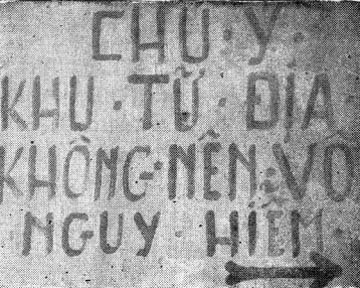 |
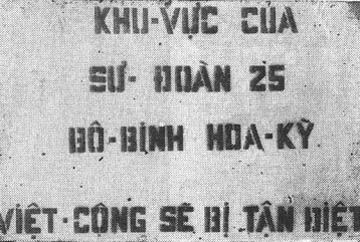 |
| VC ALOHA - The Viet Cong posted signs on trees about three miles northwest of the division base camp. Interpreted, they read: "Attention. This is a death area. Do not enter. Stay in the safe area." | ...To which the division erected counter signs announcing that "This is U.S. 25th Infantry Division country. Any Viet Cong advancing beyond this point will be shot," |
Lexington Express to Cu Chi
On a subway in New York City, a weary businessman catches a glimpse at the
evening's news on his return from a hectic day. The subway is crowded but moves
quickly.
At Cu Chi, the subways aren't so crowded anymore. In fact, most of the
underground thoroughfares no longer exist.
The passenger traffic which used to push and pant its way through more than
600 tunnel networks beneath 2nd Brigade no longer own the lease on the gigantic
subway system.
Division "tunnel runners," who explored the tunnels before destroying them
often uncovered some strange results, according to Specialist Five Fernando
Figueroa, the senior medic for Company B, 1st Battalion (Mechanized). 5th
Infantry.
On one occasion two men, so the story goes, crawled around one tunnel complex
for four or five hours and failed to reach the end of the trail.
"All of a sudden, we saw heads popping out of the ground," Figueroa
recounted. "We were just as surprised to see them as they were to see us."
"They came out perspiring, toting rusty rifles and moldy brief cases."
One confused VC commuter asked, "How do we get back?" Well, you take the
Flushing Meadows local to East 30th Street, then transfer to the Lexington
Express.
AMMO SUPPLIES FLOW AT RATE OF FIFTY TONS
Nearly 50 tons of ammunition are hauled daily by helicopter and vehicle
convoy to the division's base camp to provide a ready supply for "Tropic
Lightning" soldiers.
Major Edmund K. S. Chine, division ammunition officer, pointed out that the
ammunition supply point is stocked regularly with 137 items, including shotgun
buckshot, mortars, and Claymore mines.
Thirty to 66 vehicles bring in ammunition as small as 5.56mm for the M-16
rifle and as large as eight-inch artillery projectiles at an average of 45 tons
a day.
Reaching the base camp for distribution during February and March were almost
2.5 million rounds of ammunition for M-16s; over 50,000 rounds of M-16 tracers;
502,000 rounds of M-60 machine gun ammunition; and 44,000 high explosive 105mm
artillery rounds.
War No Object; Orphan Support Doubles
Atsuko Tokumura is nine years old. She lives in a large house, sleeps in a
clean bed and eats three good meals a day. She is just like other children, in
fact, except that she has 2,700 fathers.
An orphan at the Holy Family Home in Osaka, Japan, Atsuko's fathers are the
men of the 1st and 2nd Battalions, 27th Infantry and the 1st Battalion, 8th
Artillery. These units have been supporting the orphanage for more than 16
years, contributing more than $440,000 in cash.
Since the arrival of "Tropic Lightning" units in Vietnam, support for the
orphanage has more than doubled to more than $4,000 - more than twice as much as
in previous months.
The Osaka Orphanage protect began in December 1940, when the 27th Infantry
Regiment was based on the outskirts of Osaka. It was the custom of the division
special services office to send the name of an orphanage to each occupation
unit, which would then plan a Christmas party for the home they had been
assigned. The 27th was given the name of the Holy Family Home, which was
located about 15 minutes from their camp.
Several weeks before the party was to take place, Corporal Hugh 0' Reilly and
several other men from the "Wolfhounds," went to visit the orphanage. The
battle-hardened infantrymen almost cried when they found 140 Japanese war
orphans living in three miserable shacks.
Inside the shacks, the floors were dirt. The drawn children, suffering from
scurvy and frostbite, slept on platforms on either side of the narrow center
aisles.
O'Reilly went back to camp feeling sick. He asked some of the men of B
Company to take up a collection the next payday.
That day, December 31, 1949, the men of B Company, 143 strong, donated $143.
The word about the orphanage spread and on Jan. 31, 1950, every company in the
regiment contributed to the Holy Family Home. From that day since, the
Wolfhounds have never missed a payday contribution to the Osaka orphanage.
In 1954, the 27th left Korea for Hawaii. There, in 1955, the 1st Battalion
8th Artillery, which had fought beside the 27th in Korea, asked to join in
supporting the orphanage.
There are still three buildings at the orphanage. Now they are made of
marble and concrete and chrome and steel.
There is a pamphlet given to new soldiers when they join the units to
acquaint them with the project.
The booklet asks, "When do you expect the support of the orphanage to end?"
The answer: "On the day the 27th Infantry and the 8th Artillery no longer
have hearts."
Page 7 TROPIC LIGHTNING NEWS May 6, 1966
11,000 Mile Supply Line Gets Steaks
Steak for supper! was welcome news for everyone in the mess line.
Steak is always a treat but is extra special during field operations where
canned foods are often the rule.
On operation Longfellow the 3rd Brigade is at the end of a supply line
stretching halfway around the world. Situated more than 360 miles northwest of
Saigon, this remote area truly is the end of the line.
To get a steak from a meat packer in Nebraska to a soldier's mess kit in Tan
Canh requires a certain amount of organization. At one end of the line is the
Army purchasing agent or buyer. At the other end is the 3rd Provisional Support
Battalion, providing the men of 3rd Brigade with that occasional steak and
everything else needed to carry out their mission.
The support battalion, commanded by Major Herbert C. Evans, works with the
brigade supply officer, Major James Kirkpatrick. Their job is to see that the
brigade has the logistical support needed to be "Ready to Strike, Anywhere,
Anytime."
"Field coordinator" for the battalion, is its operations officer, Captain
John E. Stetzinger, of Portsmouth, O. The support battalion is made up of B
Company, 25th Medical Battalion, D Company 724th Maintenance Battalion, and a
provisional company from the 25th Supply and Transport Battalion.
This "miniature support command" has the capability of providing combat
service support to the 3rd Brigade Task Force.
The medical company, commanded by Captain Edward Denison, provides a medical
clearing station for the brigade. The doctors have sufficient equipment in the
field to permit minor surgery. Those soldiers with serious injuries are
evacuated to larger hospitals at Nha Trang and Qui Nhon.
Capt. Denison and his staff of doctors and medics also conduct sick calls for
the Vietnamese in the brigade's operational areas whenever time permits.
The maintenance company, commanded by Captain Charles F. Bernitt, of
Whitestone, N.Y , is given the task of keeping all the brigade's equipment
operating properly.
Chief Warrant Officer T.C.L. Crow is responsible for the field operation of
the maintenance team. His 13-man crew is called on to repair anything from a
telephone handset, which takes as little as six minutes to repair, to a tank
transmission, which often takes six hours or more to fix.
The team has tens of thousands of spare parts on hand, ranging from cotter
pins to complete M48-A3 tanks.
During a 100-mile road march from Ban Brieng to Duc Co in the recent
operation Lincoln, not one vehicle of the more than 200 in the convoy fell out.
Sergeant First Class John Cennimo heads up the supply and transport company
field operations. He has 21 men helping him to see that the brigade has all the
food, ammunition, petroleum and a thousand and one other items to sustain it in
combat.
The S and T people also provide internal transportation and one of the
biggest morale boosters in camp - a hot shower.
Ft. Benning Site of New Training Bde.
A new training brigade has been added at the Ft. Benning, Ga., Army Training
Center and another is planned for September at Ft, Huachuca, Ariz., as the Army
continues a major program to expand its training capacity.
At Ft. Benning, the new unit will be the third basic combat training brigade
to be established at the post's seven-month-old Army training center. It is
expected to reach its full strength of 4,400 basic trainees by the end of May.
Nearly 20,000 men already have been graduated from Ft. Benning's basic combat
training program.
The Ft. Huachuca brigade will be set up to give combat support training to
about 3,503 men. Training will cover clerical, mechanical, food service,
vehicle operation and similar skills.
The brigade is scheduled to begin receiving about 450 men a week sometime in
September.
Combat support training also is conducted by the Army at Fts. Leonard Wood,
Mo., Dix, N. J., Knox, Ky., Ord., Calif., Jackson, S. C., and Polk, La.
1/5th Maintenance Repairs Tracks
The maintenance section of the 1st Battalion (Mechanized), 5th Infantry has
found itself working around the clock since arriving at Cu Chi.
The Viet Cong had mined enough rice paddies and hedgerows to keep the 35-man
maintenance section busy from sunup until sundown during the initial phases of
2nd Brigade operations, while blackout was in effect.
Now, with blackout lifted, the lights run long into the night over new or
repaired engines being stuffed into the yawning engine compartments of the
armored personnel carriers.
"The combination of the enemy mines and the almost constant operations of the
battalion first caused us quite a heavy workload," said Chief Warrant Officer
Arthur H. Alderson, of Virginia, Minn., the maintenance technician. "Now the
work has slacked off a bit, but not much. Just the other night the section
worked until 1 a.m., making repairs and preparing the battalion reconnaissance
platoon for an early mission the next day."
The weather adds to the difficulties. "It gets awfully hot during the
afternoon," said Sergeant first Class Robert C. Van Horn, of Meadville, Penna.,
assistant motor sergeant. "So hot that the men can't even hold onto a wrench."
But the work goes on. A personnel carrier needs one hour of maintenance for
every four hours of running time, according to CWO Alderson. The assembly of
one track for one side of a personnel carrier takes two men about four hours.
"It's not like a wheeled vehicle," he said emphatically. "When a tire blows
on a jeep, you just put on another tire, but when a track goes, it can mean four
to eight hours of back-breaking work."
Even more back-breaking and somewhat more dangerous is the work encountered
by the mechanics who accompany the personnel carriers in the field. If a
personnel carrier breaks down or hits a mine, the mechanics stay behind and make
the repairs on the spot while the operation continues.
When you fight the Viet Cong, you have no safe, behind-the-lines area, so
sometimes the mechanics make their repairs under fire. In spite of all this the
morale of the section is outstanding, typified by Specialist Five Elmer
McBurrows, of Macon, Ga., a senior mechanic who could have rotated several weeks
ago, but decided to stay and work with the boys awhile.
In a recent briefing, Lieutenant Colonel Thomas U. Greer, 1/5th commander,
observed, "In spite of the fact that the drivers of this unit have done an
outstanding first echelon maintenance job, were it not for the sound technical
knowledge and magnificent effort of the maintenance section this unit would have
long ago ground to a halt."
There are no Purple Hearts issued to the members of the maintenance section
but there are plenty of "metals."
AER: Designed to Serve
Army Emergency Relief (AER) was established in February 1942, to render
emergency financial assistance to Army personnel.
All members of the Army on active duty and their dependents; Army members who
have retired after 20 or more years of active duty, and their dependents; Army
members retired because of physical disability incurred in line of duty and
their dependents; widows and orphans of Regular Army Personnel; and dependents
under the AER program.
Funds are provided for voluntary contributions made by members of the Army
each year to support the program.
The program within the 25th Infantry Division is supervised by the division's
Personnel Actions Branch. Loans and/or grants of up to $250 may be made, by the
division AER section to division members or their dependents when faced with
emergency financial conditions which are beyond their ability to meet.
Individuals requiring emergency financial assistance may apply for an AER
loan or grant by completing DA Form 1103 (Application for Financial Assistance)
in two copies. The application will be processed by the division AER officer.
AER assistance may be granted in such emergencies as non-receipt of pay,
allotments, or allowances; loss of pay or other personal funds; emergency
medical, dental, or hospital expenses; payment of initial rent or payment to
prevent eviction; and other privations of dependents due to emergencies.
However, AER is not meant to be an umbrella insurance program, and assistance
normally is not extended in such cases as: divorces; liquidation of debts not
arising from an emergency; chronic or prolonged illnesses and institutional care
on a long term basis; fire or other disasters except to prevent undue hardship, financing of business ventures;
civilian court fees; fines, bail; and non-emergency travel expenses.
Division personnel are urged to apply for AER relief whenever an emergency
financial situation arises that cannot be handled through the American National
Red Cross or similar organizations.
MACV Gives Advice On Vietnam Conduct
The U.S. Military Assistance Command (MACV) Vietnam, has issued a warning to
American servicemen to exercise care in their contacts with the Vietnamese
people during combat operations.
The MACV warning was aimed particularly at the practice of reconnaissance by
fire into villages which may contain friendly civilians. American military men
were also cautioned against the unnecessary killing of livestock, a practice
which can alienate non-combatant Vietnamese against the American military
mission here.
Although it is often necessary to prevent buildings and property from falling
into Viet Cong hands by destroying them, care should be taken to insure that the
property of friendly civilians is not destroyed in the process.
At the same time, U.S. forces must demonstrate their concern for the safety
of non-combatants, their interest in the injured and their willingness to help
the sick, the hungry and the homeless.
AAA Road Service Keeps OH's Running
"You can't stop on a cloud and call a wrecker to pull you in when you have
trouble. That sums up aircraft maintenance," Specialist Five Anthony Sipko Jr.,
observed.
Sipko, of Wahiawa, Hawaii, is the technical inspector and line chief for the
division's 2nd Brigade aviation section.
The section, known as the "Menehunes," has the first Hiller OH-23 helicopters
to arrive in Vietnam.
The crew chiefs of the maintenance section - Specialists Five James
Stevenson, Carl Cornwell, Phillip Smith and Specialist Four Ronald Takushi - put
in several hours daily on their choppers.
After each flight, the helicopter's crew chief must inspect it. There is a
daily inspection, a 25-hour inspection, a 100-hour inspection, and a variety of
special checks. Thirty-one items must be checked on the daily maintenance
sheet, including cleaning and polishing the bubble, which takes at least two
hours, according to the "Meneihunes." In addition, there is normal servicing
and, after three flight hours, the entire tail section has to be greased.
These four "bubbles," used for aerial observation, reconnaissance, and
artillery forward observation really have had a workout. In the first three
months of flying, nearly 2,000 hours have been entered in the log books.
"That's a lot of flying," Sipko said, "and it also means a lot of
maintenance."
"Each day different problems arise," Sipko continues. "Our biggest problem
is people not knowing how to ride in the chopper. The other day a guy got in
and dropped a PRC- 10 radio onto the bubble, breaking the lower portion. That's
a $200 job."
The "Menehunes," who try to keep three of the four $67,000 choppers in the
air at all times, are supervised by Sergeant First Class Edward Lanehart. PFC
David Clevenger is in charge of all petroleum products used by the "Menehunes."
Page 8 TROPIC LIGHTNING NEWS May 6, 1966
11 Cited For Combat Action
Eleven 25th Infantry Division soldiers were decorated last week for heroism
in connection with military operations in Vietnam.
Nine soldiers received the Bronze Star Medal and two received the Army
Commendation Medal. All awards were with the "V" device.
The following received the Bronze Star Medal:
First Lieutenant James V. Accardi, 1st Battalion. 8th Artillery, who
distinguished himself on Feb. 5, 1966, while assigned to Company A, 1st
Battalion, 27th Infantry, as an artillery forward observer. Lt. Accardi lifted
artillery fires to allow evacuation helicopters to land in the area. He then
assumed command of a platoon evacuating wounded from a rice paddy and continued
controlling the unit until armored personnel carriers (APC) arrived to cover
the company's removal.
First Lieutenant L. B. Snyder, II, and Specialist Five Robert Hulsehus, Jr.,
Troop A, 3d Squadron, 4th cavalry, were cited for action on March 29, 1966. Lt.
Snyder, while serving as the troop executive officer, and Specialist Hulsebus,
troop medic, monitored a radio call from one of the tanks which had two badly
wounded crew members.
They left the safety of their APC and succeeded in saving the life of one
wounded crew member who was bleeding badly from a rifle wound.
First Lieutenant Lawrence A, Walker, Company A, 1st Battalion, 27th Infantry,
was serving as a platoon leader on Feb. 5, 1966, when his platoon became heavily
engaged with the enemy while maneuvering in a rice paddy. After the initial
evacuation of the wounded, Lt. Walker and two sergeants returned to the rice paddy and successfully evacuated two
more casualties to the company perimeter.
Staff Sergeant Roscoe W. Frazier, Company B, 1/27th Inf., was with a 16-man
patrol from April 1 to April 3, 1966. He dropped back from the main company's
move to friendly lines and continued to harass and gather information about the
enemy.
Without sleep, he gave constant encouragement and checked his patrol
positions. At approximately 7:10 a.m., April 3, Sgt. Frazier detected a Viet
Cong near the patrol position and personally killed the enemy.
For the next five hours, his patrol was under intense sniper fire from all
directions. During this time, Sgt. Frazier moved from man to man, offering
encouragement and pointing out targets.
Staff Sergeant Robert L. Little, Sergeant Meredith G. Hubbard and Sergeant
Michael J. Mummel, all of Company A, l/27th Inf., all were decorated for action
on Feb. 5, 1966. All three, volunteered to help evacuate a deceased comrade and
a wounded soldier from a rice paddy in which their unit was operating.
PFC Herman Mounts, Jr., Battery C. 1st Battalion, 8th Artillery,
distinguished himself on April 2, 1966, while assigned to Company A, 1st
Battalion (Mechanized), 5th Infantry, as the radio-telephone operator for the
artillery forward observer team.
The tracked vehicle in which Mounts was riding was struck by a
command-detonated mine, completely destroying it and rolling the vehicle over
three times. Wounded in the head, Mounts tried to radio for help on the vehicle
radio, which was inoperative.
He then ran through heavy enemy fire to another radio and requested medical
help for the wounded men in the damaged APC. Mounts returned to the disabled
vehicle and assisted in evacuating dead and wounded until relieved by the rest
of the company.
Platoon Sergeant George A. Burrows, and Specialist Four Sam Scott, Company B,
2nd Battalion, 27th Infantry, were awarded Army Commendation Medals for action
on Feb. 24, 1966. They were on a combat night deception patrol and were
covering a night ambush patrol when they discovered the flanks of the two
patrols would cross.
Failure to contact the ambush patrol by radio caused the two men to position
themselves between the two patrols which resulted, because of darkness, in both
of them being wounded by members of the ambush patrol.
Despite their wounds and an increasing loss of blood, both continued in their
efforts and were successful in obtaining a cease fire, preventing other members
of both patrols from being wounded.
You're It
"Tunnel Rat" Plays Grenade Hot Potato
His veteran platoon sergeant says, "You won't find a braver man in the Army.
At least I've never seen one."
But Specialist Four Andres Ramirez, of Snyder, Tex., shrugs off the
compliment. For him, seeking out the elusive Viet Cong in tunnels and trenches
is all in a day's work.
The 19-year-old Ramirez says he can't understand the Viet Cong. "When I've searched a tunnel, I have found dope and needles. You know, they give 'em
dope, hand 'em a few rifle grenades, some bandoliers of ammunition, and say 'go
kill some Americans'."
Specialist Ramirez, who is only 5 feet 4 inches tall and weighs 120 pounds,
was an automatic rifleman before being promoted to team leader. "I liked the
weapon. It wasn't too heavy for me - you just have to learn how to use lt."
The holder of two Purple Hearts for wounds received in combat with the 2nd
Battalion, 27th Infantry, the spirited youth has been involved in clearing
numerous VC tunnels.
"Once, my company was working an area and we found a trap door. I listened
and could hear the VC talking. I got a .45 pistol and a flashlight and crawled
in."
Here, Ramirez' platoon sergeant interrupted the story. "You never saw
anything like it in your life. He went in that tunnel, and about five seconds
later came flying out."
"There was an explosion in the tunnel. Ramirez grabbed a grenade and went
right back in and threw the bomb: We pulled six VC out of there."
Ramirez explained what happened. "When I got in the tunnel I saw a flash,
like the kind that comes from an old type grenade. I looked and saw a second
trap door closing. As soon as Charlie's grenade went off, I dropped my own into
his trap door." One rifle, two radios, a tape recorder, transmitter and
microphone were recovered from that tunnel.
Of the enemy, Ramirez says, "They're sneaky. The only ones I've seen were
the dead ones I killed."
Monkeyshines Cause Red Combat Faces
When Sergeant Gilbert Lewis, a team leader for Company B, 1st Battalion
(Mechanized), 5th Infantry, saw the brush moving in the battalion outpost he
sent out two infantrymen to investigate.
Armed with automatic M-16 rifles, the two men dashed through the brush, ready
to open fire on any enemy movement. Instead they found nothing more than a big
monkey climbing a tree.
"We didn't fire at him," Sergeant Lewis, of Taylor, Mich., announced. "He
was unarmed. A friendly."
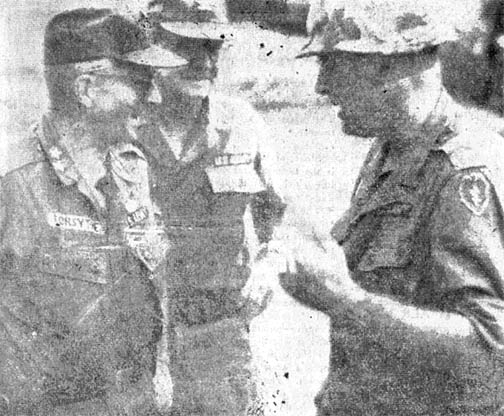 |
Maj. Gen. George T. Forsythe, U.S. Army, Pacific, G-2, and former assistant division commander/support for the division, is briefed by Lt. Col. Harley F. Mooney, 1st Battalion, 27th Infantry, commander, on an operation near Duc Lap. With them is Colonel Edward King, USARPAC G-3. General Forsythe visited the division's base camp at Cu Chi Sunday, where he was greeted by Major General Fred C.Weyand. Part of his tour included a trip to the 1/27th operational area. |
Thanks to:
The 25th Infantry Division Museum for providing the volume of 1966 Tropic
Lightning News,
Ron Leonard, 25th Aviation Battalion for finding and mailing them,
Kirk Ramsey, 2nd Bn., 14th Inf. for creating this page.
This page last modified 08-20-2006
©2006 25th Infantry Division Association. All rights reserved.